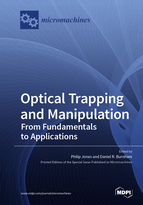Optical Trapping and Manipulation: From Fundamentals to Applications
A special issue of Micromachines (ISSN 2072-666X). This special issue belongs to the section "A:Physics".
Deadline for manuscript submissions: closed (30 November 2019) | Viewed by 37019
Special Issue Editors
Interests: optical tweezers; optical binding; singular optics; biophysics
Special Issues, Collections and Topics in MDPI journals
Interests: optical tweezers; DNA replication; biophysics
Special Issues, Collections and Topics in MDPI journals
Special Issue Information
Dear Colleagues,
We are pleased to announce a Special Issue of Micromachines dedicated to the latest research in optical trapping, to be titled “Optical Trapping and Manipulation: From Fundamentals to Applications” and scheduled for publication in 2019.
In recognition of the broad impact of optical manipulation techniques across disciplines, the Special Issue will welcome contributions on all aspects of optical trapping and manipulation. These may comprise both theoretical and experimental studies, and applications of optical manipulation methods in fields including (but not limited to) single molecule biophysics, cell biology, nanotechnology, atmospheric chemistry, and fundamental optics will be particularly welcome in order to showcase the breadth of the current research.
The Special Issue will accept diverse forms of contributions, including research papers, short communications, methods, and review articles that represent the state-of-the-art in optical trapping.
Prof. Philip Jones
Dr. Daniel R. Burnham
Guest Editors
Manuscript Submission Information
Manuscripts should be submitted online at www.mdpi.com by registering and logging in to this website. Once you are registered, click here to go to the submission form. Manuscripts can be submitted until the deadline. All submissions that pass pre-check are peer-reviewed. Accepted papers will be published continuously in the journal (as soon as accepted) and will be listed together on the special issue website. Research articles, review articles as well as short communications are invited. For planned papers, a title and short abstract (about 100 words) can be sent to the Editorial Office for announcement on this website.
Submitted manuscripts should not have been published previously, nor be under consideration for publication elsewhere (except conference proceedings papers). All manuscripts are thoroughly refereed through a single-blind peer-review process. A guide for authors and other relevant information for submission of manuscripts is available on the Instructions for Authors page. Micromachines is an international peer-reviewed open access monthly journal published by MDPI.
Please visit the Instructions for Authors page before submitting a manuscript. The Article Processing Charge (APC) for publication in this open access journal is 2600 CHF (Swiss Francs). Submitted papers should be well formatted and use good English. Authors may use MDPI's English editing service prior to publication or during author revisions.
Keywords
- Optical tweezers
- Optical trapping
- Optical manipulation








